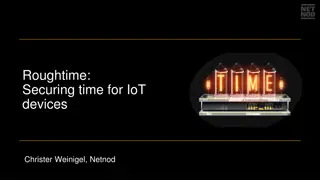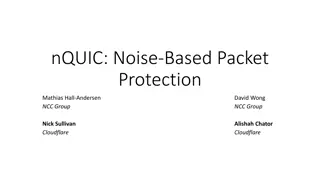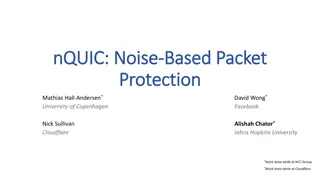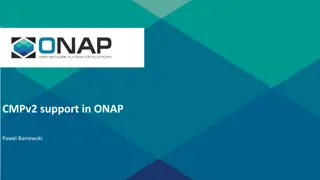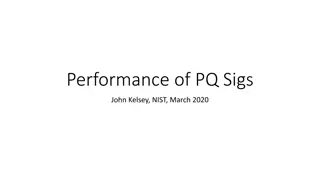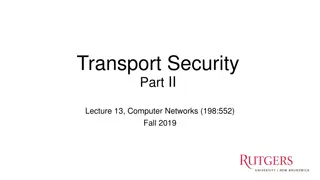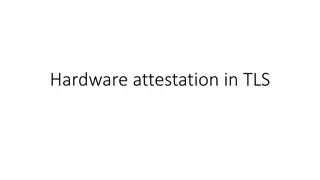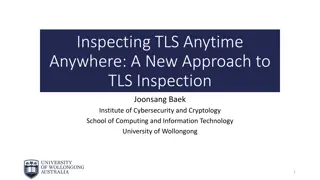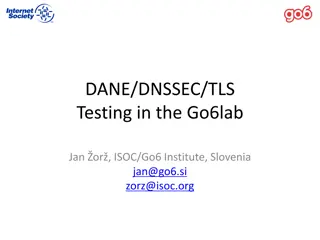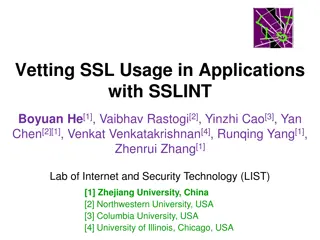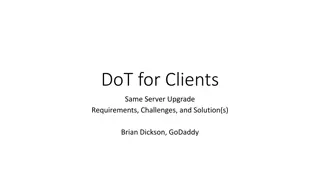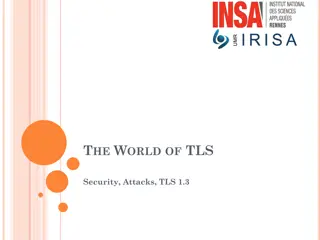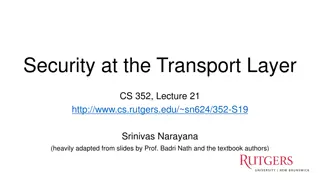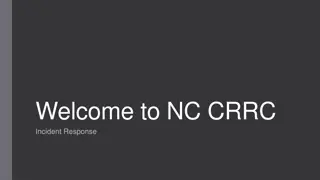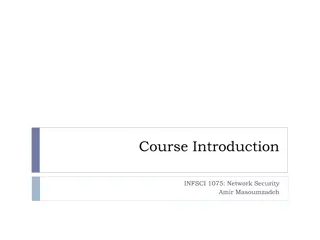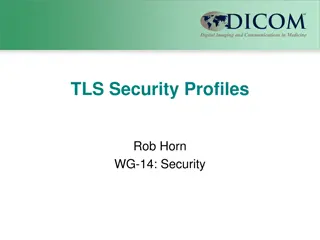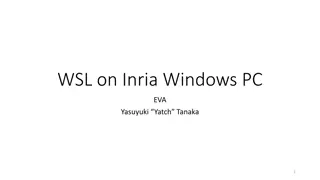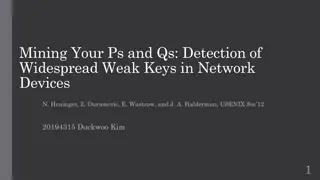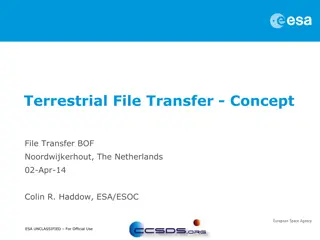Best Practices for Accessible PowerPoint Presentations
Learn the guidelines and best practices for creating accessible PowerPoint presentations to meet WCAG AA requirements. Access resources from Carleton TLS and Microsoft PowerPoint support websites for assistance.
2 views • 18 slides
Roughtime: Securing time for IoT devices
Accurate time is crucial for security protocols like DNSSEC and TLS in IoT devices. Roughtime protocol, with improved accuracy and security features, provides a solution for securing time in resource-constrained environments. The protocol addresses the bootstrapping problem and allows for microsecon
1 views • 8 slides
Challenges in Standard QUIC Protocol Implementation
The content discusses the challenges and shortcomings of the standard QUIC protocol implementation, focusing on the use of TLS 1.3 for cryptographic handshake. It highlights issues such as complexity in implementation and state machine, lack of a full security proof, and the risk of ossification due
0 views • 108 slides
Enhancing Eduroam Security with New Standards and Practices
Explore the foundations of eduroam and the challenges with RADIUS, along with recommendations for improving security. Learn why moving away from RADIUS/UDP and adopting shared secrets of 16 characters is essential. Discover the issues with transitioning from UDP to RADIUS/TLS, and the new standards
0 views • 12 slides
Modernizing Network Security with nQUIC Noise-Based Packet Protection
Explore the evolution of network security mechanisms through nQUIC Noise protocol, comparing it against traditional HTTPS stack. Delve into the secure transmission aspects of TCP/IP, TLS, and the innovative approaches of QUIC protocol, emphasizing the significance of securing protocols with TLS in m
2 views • 119 slides
Understanding TLS v1.3: Enhancing Round-Trip Times and SSL Configuration
Delve into the intricacies of TLS v1.3 updates, exploring the significance of round-trip times in pre-TLS v1.3, the integration of 0-RTT and 1-RTT in TLS v1.3. Discover key configurations like SSL_CTX_set_max_early_data and SSL_CTX_set_options, as well as the implementation nuances in SSL.
1 views • 13 slides
Understanding Why CMPv2 and X.509 Certificates are Essential for Secured Communication in ONAP
Explore the significance of CMPv2 and X.509 certificates for establishing secured communication within the ONAP ecosystem. Learn about the challenges faced in ONAP Istanbul and the role of TLS in ensuring privacy, data integrity, and authentication between network functions and ONAP components.
0 views • 15 slides
Performance of Post-Quantum Signatures: Analysis and Comparison
Explore the performance and characteristics of various post-quantum signature schemes including Lattice-based Dilithium, QTesla, Falcon, Symmetric Sphincs+, Picnic, Multivariate GEMSS, Rainbow, and more. Understand the implications of using these schemes in TLS, code signing, firmware updates, signe
0 views • 29 slides
Understanding Transport Layer Security (TLS)
The lecture discusses key security properties essential for secure communication in computer networks, such as confidentiality, integrity, authentication, and non-repudiation. It elaborates on cryptographic mechanisms for achieving these properties and emphasizes modularity and reusability in implem
1 views • 26 slides
5G Use Case Proposal for Dublin Ericsson
This proposal outlines the use of NETCONF for configuration management in 5G networks, focusing on Dublin. It covers topics like Configuration with NETCONF, NETCONF Overview, NETCONF Security, YANG Overview, and Proposed Use Cases and Requirements for Dublin. The proposal emphasizes the importance o
7 views • 20 slides
Enhancing Security with Hardware Attestation in TLS
The hardware attestation in TLS presentation explores the theory and practice of remote attestation, emphasizing the need to improve workload authentication beyond software-bound trust. It delves into the use cases, remote attestation data flow, and the significance of Transport Layer Security (TLS)
0 views • 29 slides
A New Approach to TLS Inspection
This article explores a new approach called IA2-TLS for inspecting Transport Layer Security (TLS) anytime and anywhere. It discusses the primary goals of TLS, the increasing importance of data encryption over networks, and the need for TLS inspection to enhance security controls. The challenges of i
1 views • 46 slides
Exploring DANE, DNSSEC, and TLS in Go6Lab
Delve into the implementation of DANE, DNSSEC, and TLS protocols at Go6Lab, a testing facility affiliated with ISOC/Go6 Institute in Slovenia. The setup includes DNSSEC implementation with PowerDNS and OpenDNSSEC, DANE experimentation with Postfix servers, and verification processes for TLS certific
0 views • 36 slides
Automated Detection of SSL Vulnerabilities in Applications
This research introduces SSLint, a systematic approach and automated tool for detecting incorrect SSL API usage vulnerabilities in applications. By analyzing millions of lines of code, the tool discovered previously unknown SSL/TLS vulnerable apps. The study addresses the motivation, problem stateme
0 views • 29 slides
Upgrade Requirements, Challenges, and Solutions for Same-Server DoT Implementation
Explore the transition from Do53 to DoT without changing resolvers, addressing challenges in DNS resolvers, TLS standards, and forwarder complications. Discover partial solutions through DANE TLSA certificates, DNS zone publishing, and DNSSEC trust anchors for enhanced security and upgrade process e
0 views • 14 slides
Understanding TLS/SSL: Security, Attacks, and TLS 1.3
Learn about the world of TLS/SSL security, attacks, and the latest TLS 1.3 protocol. Explore how TLS ensures confidentiality and authenticity of communications, the client-server scenario in online shopping, a bit of history from SSL to TLS, and insights into different TLS versions and their securit
0 views • 37 slides
Understanding Transport Layer Security (TLS) and Secure Sockets Layer (SSL)
This content delves into the concepts of Transport Layer Security (TLS) and Secure Sockets Layer (SSL), exploring their origins, application in web security, and protocol stack integration. It covers the TLS/SSL handshake process, key derivation, data transfer mechanisms, and the significance of the
0 views • 26 slides
Network Monitoring Workshop - Incident Response Overview
This workshop covers various aspects of incident response, including tools and techniques such as network taps, protocol analysis with Wireshark, data summarization with Bro/Zeek, alerting with Snort/Suricata, and more. Sessions delve into topics like TLS inspection, wireless network monitoring, and
0 views • 17 slides
TLS Freight Forwarding Pvt Ltd: Your Business Partner for Complete Logistics & Supply Chain Solutions
TLS Freight Forwarding Pvt Ltd is a leading third-party logistics service provider operational in major cities of Pakistan, offering logistics, supply chain, and brokerage services. With a mission to exceed customer expectations, TLS provides global reach, multi-modal services, IT solutions for real
0 views • 13 slides
Understanding Domain Names for Authoritative DNS Servers
Researchers need to accurately define the types of authoritative DNS servers they sample when measuring server properties. This study focuses on collecting domain names used for web servers to assess typical domain name characteristics, highlighting the importance of accurate data for research purpo
0 views • 7 slides
Practical Aspects of Modern Cryptography: November 2016
Exploring session-based protocols, SSL/TLS, certificates, and public key infrastructure, this presentation delves into the motivation behind secure online interactions, discussing the importance of verifying identities, ensuring data confidentiality, maintaining message integrity, and authenticating
0 views • 137 slides
Network Security Course Overview - INFSCI 1075 by Amir Masoumzadeh
Network Security Course INFSCI 1075 by Amir Masoumzadeh focuses on security issues in networks, covering common attacks, prevention, detection, protocols like IPSec and SSL/TLS, cryptographic protocols, and more. The course prerequisites include knowledge of TCP/IP, algebra, digital logic, and basic
0 views • 16 slides
Evolution of TLS Security Profiles and Best Practices
TLS security profiles have evolved with the introduction of new profiles, retirement of old ones, and emphasis on non-downgrading best practices. Motivated by changes in security threats and cryptographic methods, the IETF has issued recommendations to ensure secure connections using TLS 1.2. The ne
0 views • 5 slides
Troubleshooting WSL Issues on Inria Windows PC
WSL (Windows Subsystem for Linux) on Inria Windows PC can face issues with apt install, npm install, and Git clone due to Kaspersky Endpoint Security blocking TLS/SSL communications. A workaround involving tunneling through SSH and using proxychains4 can help resolve these problems. This guide provi
0 views • 6 slides
Weak Keys Detection in Network Devices
TLS and SSH rely on RSA and DSA for security, but weaknesses in random number generation can lead to widespread weak keys among hosts on the Internet. This paper uncovers the prevalence of repeated keys and easily inferred private keys, emphasizing the importance of entropy pools in key generation.
0 views • 28 slides
Benefits of Free SSL with Let's Encrypt for Website Security
Explore the advantages of implementing free SSL with Let's Encrypt for your website security needs. Discover why SSL/TLS encryption is essential to prevent insecure warnings in browsers, enhance search engine rankings, and comply with Apple's secure app requirements. Learn about the pain points asso
0 views • 25 slides
Terrestrial File Transfer Concept: Design Goals and Protocols
This document discusses the concept of terrestrial file transfer as presented in a series of slides from an ESA event in Noordwijkerhout, The Netherlands. It covers the purpose, design goals, protocols, and transport protocols involved in exchanging files between agencies for mission design, operati
0 views • 20 slides

